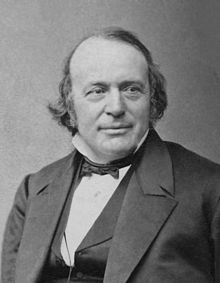Louis Agassiz
| Louis Agassiz | |
|---|---|
 |
|
| Born |
May 28, 1807 Haut-Vully, Switzerland |
| Died | December 14, 1873 (aged 66) Cambridge, Massachusetts, U.S. |
| Fields | |
| Institutions |
University of Neuchâtel Harvard University Cornell University |
| Alma mater | University of Erlangen-Nuremberg |
| Doctoral advisor | Carl Friedrich Philipp von Martius |
| Other academic advisors | Ignaz Döllinger, Georges Cuvier, Alexander von Humboldt |
| Notable students | William Stimpson, William Healey Dall, Karl Vogt |
| Known for | Polygenism |
| Notable awards | Wollaston Medal (1836) |
| Spouse | Cecilie Braun Elizabeth Cabot Cary |
| Children | Alexander, Ida, and Pauline |
| Signature | |
Jean Louis Rodolphe Agassiz (English /ˈæɡəsi/; French: [agasi]; May 28, 1807 – December 14, 1873) was a Swiss-American biologist and geologist recognized as an innovative and prodigious scholar of Earth's natural history, with later American writings that have received scrutiny because of particular racial themes. Agassiz grew up in Switzerland, and studied and received Doctor of Philosophy and medical degrees at Erlangen and Munich, respectively. After further studies with Cuvier and Humboldt in Paris, Agassiz proceeded with research leading to his appointment as professor of natural history at University of Neuchâtel.
After visiting Harvard University mid-career, he emigrated to the U.S. in 1847 and became a professor of zoology and geology at Harvard, and to head its Lawrence Scientific School and found its Museum of Comparative Zoology. Agassiz made extensive contributions to ichthyological classification (including of extinct species) and to the study of geological history (including to the founding of glaciology), and has become broadly known through study of his thorough regimen of observational data gathering and analysis. He made vast institutional and scientific contributions to zoology, geology, and related areas—including many multi-volume research series running to thousands of pages.
...
Wikipedia
